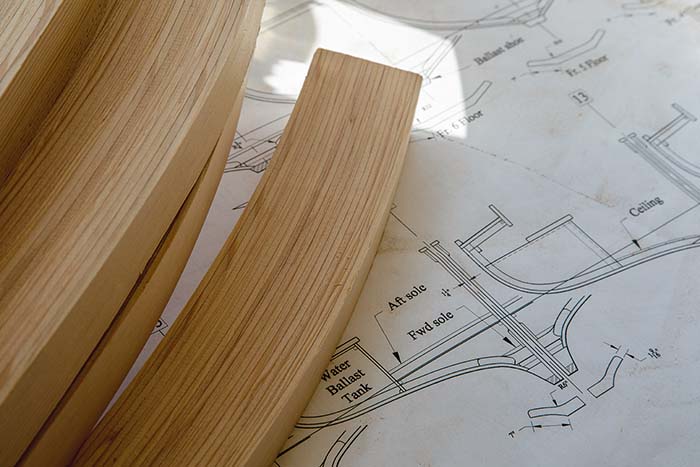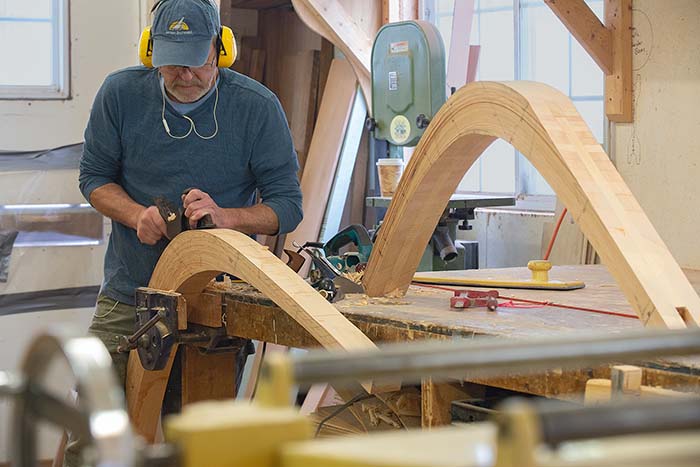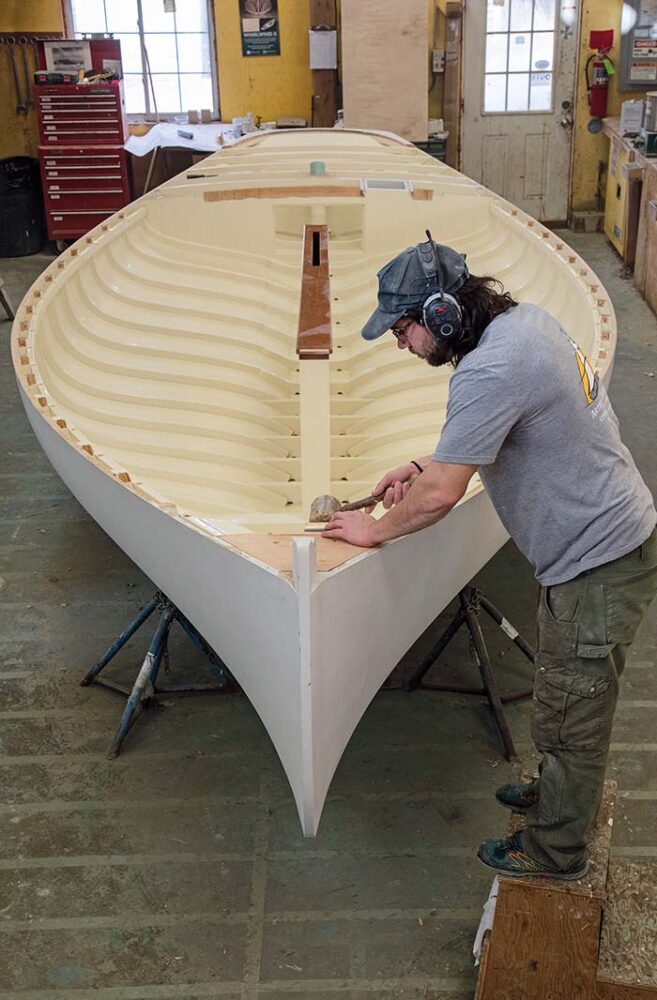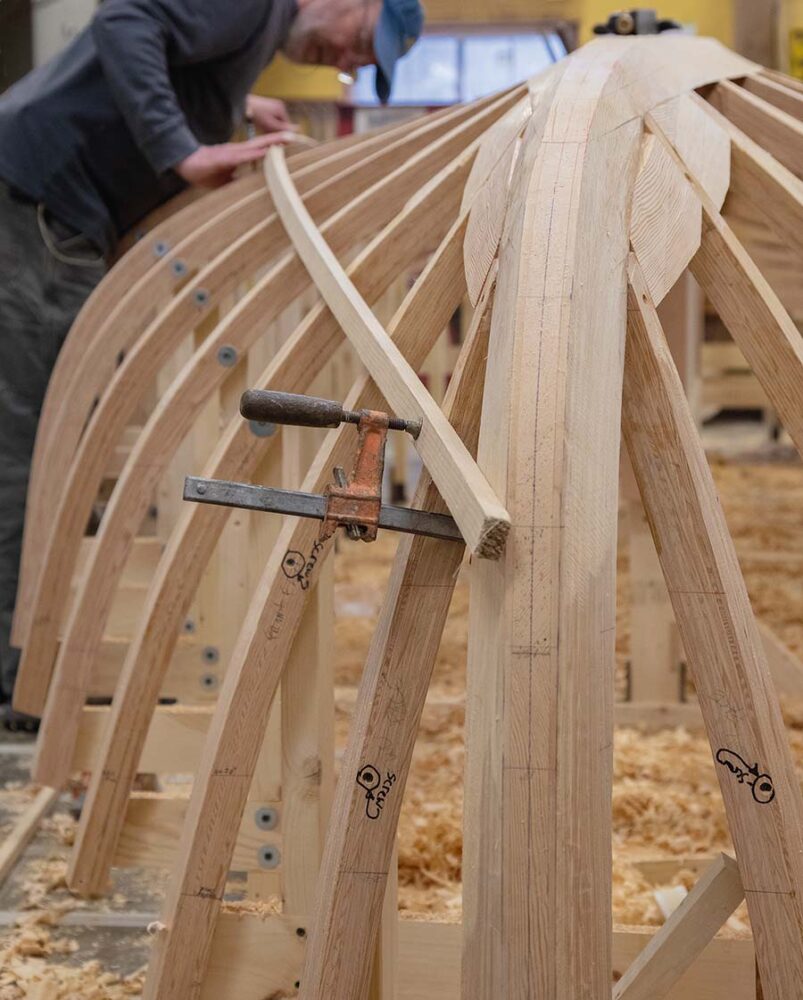Whirlwind II: Evolution of a Boat
Celebrating Maritime Heritage
By Elaine Lembo| Photographs by Alison LangleyWhat leads a man raised far from the sea to salt water, sailing, boats, and an uncharted destiny?
“Dreams and fantasies,” says soft-spoken Yarrow Thorne as he relaxes with friends and family—among them Fern, his baby daughter—in the backyard of his waterfront home on Enfield Avenue in Wickford.
Pairing the words “waterfront” and “home” can conjure up pricey imagery. Yet this is one of the more modest, grittier neighborhoods in the quaint, colonial village of Wickford. Over the decades, Enfield Avenue has served as a hub for quahoggers, captains, shipwrights, sailors, and, in waves, motorcycle enthusiasts and balladeers.
The neighborhood is also the future home of Whirlwind II, the catboat Thorne and his wife, Mary, plan to berth at their dock in the grasslands-soothed backwaters, when they’re not out sailing her and engaging the public in a dialogue about sailing and boatbuilding.
Thorne doesn’t give off the vibe of a harried new boat owner. He’s not stressed over finding a blemish in the varnish, a missing bung cover for a screw, or a lack of twist in the Dacron sails of a recreational craft whose 2025 arrival has already attracted considerable attention in domestic and international sailing circles.
What really preoccupies the 46-year-old designer and artist, who’s also the founder and executive director of The Avenue Concept and its larger-than-life murals and sculptural installations gracing urban areas of Rhode Island, are the types of priorities he’s become known for in the public sphere: devotion to process, storytelling, bringing people together, educating, and creating community.
“What’s the best way for the public to learn about this project?” is a question he asked himself when deciding that the construction of this vessel should happen in a way that honors the design’s historic roots and should be shared with the world.
Part of the answer is in its documentation. To capture the artistry of the Whirlwind II project and invite the public to follow a rich celebration of craft, history, technology, and sailing, Thorne assembled a team experienced in yacht design and engineering, as well as interviewing, photography, art, videography, and social media. They’ve produced a website, blogs, videos, and posts. “Now we have thousands of people interested in learning more,” Thorne says.

Whirlwind II’s design represents a union of traditional practices with proven modern materials and methods.
Admirers and the curious can also follow the adventure once the catboat is sailing and hosting educational programs in Narragansett Bay. With its origins reaching back at least a decade to conversations on the high side of a Marshall catboat racing weeknights in Wickford, the 26-foot Whirlwind II, in progressive stages at Artisan Boatworks in Maine, is constructed to be a daysailer, racer, and conversation starter for family, friends, and the public.
Its design is a union of the fast late-19th century oyster boats-turned racing catboats created by Gil Smith of Long Island, New York, proven modern materials, and methods such as three-dimensional laser scanning devices and computer software.
Ezra Smith of Newport Yacht Builders—Thorne’s Wickford neighbor, fellow Rhode Island School of Design (RISD) alum, and longtime sailing pal—is manager of the undertaking to marry the traditional with the contemporary and create something entirely new. (Ezra Smith is unrelated to Gil Smith.)
Besides Smith, such a multi-faceted effort draws on the talents of a host of Rhode Islanders past and present, from the innovative engineering successes of the renowned Herreshoffs of Bristol to the composites systems building skills of the Oliver Moore Brothers Company, also of Bristol, who built the mast and gaff, another spar, from light carbon fiber.
“We wanted the boat to look very traditional and be historically accurate,” Smith says. “The essence of the Gil Smith boat is the hull shape—its very cool, carved shape. Whirlwind II’s hull is strip planked and clad in fiberglass on the outside so the boat’s easier to maintain. I have experience taking old designs and rigging them in a modern way, not even changing the sail plan, but rigging them with better blocks [pulleys], better layout, better sails, then racing them. It’s eye opening to see how these boats come alive.”
“If [Gil] Smith could have taken weight out of the rig, would he have? Yeah, he probably would have. If he could have had a sail out of stiffer material, would he have done that? Yes. Frictionless blocks? Yes, absolutely. Any of these guys would have. Herreshoff is the perfect example. If he had carbon fiber, he would have used it,” Smith says. “He pushed the materials he had to a bleeding edge.”

Yet Gil Smith, whose customers were the working class as well as weekend recreational racers, functioned in an environment well removed from the epicenter of early 20th century America’s Cup yachts, and Thorne is proud that Whirlwind II carries a unique, Smith-inspired gestalt, one that he’s putting on display in homage to Smith as well as the team he’s assembled.
“I believe that Gil Smith designed and built his boats in the 1800s to support the natural world around us, and that being small and nimble allowed him to design a very contemporary boat that was ahead of his time, using simple tools,” Thorne says.
Thorne also emphasizes that he wasn’t interested in building this boat as quickly as possible.
“It was always about breaking it out into chunks and doing it over a long period of time so we can capture the story and learn as much as possible. We went through a research phase, building the team, going to Long Island, looking at a lot of Smith replicas, finding the right boat, finding the model, choosing the right drawings, scanning the model, selecting a builder, choosing materials, and starting construction,” he says.
The generous timeframe is an inherent component of Thorne’s focus on artistic process. The planned launch date is spring 2025. By spring 2023, the catboat was well on its way. Progress included application of “faux wood” paint to the spars to lend a traditional appearance, finish work to the rudder and centerboard, creation of a sail plan and rigging design, and fairing and painting the topsides and hull. The boat now enters a two-year storage hiatus while Thorne and team draw up a three-point program that includes storytelling, education, and sailing.
Building Relationships, Family, Community
As for the amazing people: From project manager Smith, to Mary, an experienced captain, sailboat racer, and outdoor educator, they aren’t just involved with Thorne’s project to build a catboat—every relationship has also yielded a new clue toward the fulfillment of a personal odyssey, bringing long-held goals into focus and fruition.
In ebbs and flows, it’s a compelling story of a young man raised in Northampton, Massachusetts, whose dyslexia drew him to tactile activities and physical outdoor exercise—hiking, skiing, and mountain climbing. Ultimately, he headed east to RISD to unpack his passion for hands-on projects and artistic experimentation. From uncovering bits of family history to scraping together a living in Providence and then stumbling on the Smith catboat design, Thorne steadfastly picked up the crumbs on the trail.
Throughout, one thing was certain: Something tugged at Thorne. “I wanted to find a way to make the ocean a part of my life,” he says. “I had no idea how to do it.”
So he volunteered at the Community Boating Center in Providence. Then an uncle gave him an older version of a two-person high performance racing dinghy with a trapeze, called an International 14, that he couldn’t figure out how to rig or sail, but which he kept in his shop, determined to learn how. And on a tip that getting a crew spot aboard Newport’s J/24 fleet was easy, he bought beer, drove south, and walked the docks. “I’d show up and hear either, ‘You weigh too much, you weigh too little, you brought the wrong beer,’” he says.
He took a few steps back, and it wasn’t long before he discovered a few alluring facts about ancestors on both sides of his family.
The tale of great-grandfather Landon K. Thorne’s 1930 effort to defend the America’s Cup against repeat challenger Sir Thomas Lipton with an experimental L. Francis Herreshoff-designed J-class racer named Whirlwind is detailed in Tuxedo Park by author Jennet Conant.
For the younger Thorne, the revelation was an affirmation of a drive akin to a genetic trait—a passion for testing new ideas on the water. Things started to click.
The late Thorne circulated in the high-flying yachting circles of wealth, power, and influence in early 20th century America. His personal friend-ship and professional partnership with Wall Street tycoon and scientist Alfred Lee Loomis compelled the duo to compete for the oldest trophy in international sport. And Thorne didn’t just finance and manage the boat, he helmed it.
“Whirlwind, which took its name from a famous clipper ship owned by a Thorne ancestor, was destined to be no ordinary racing sloop,” Conant writes. “The boat featured a highly original, innovative—and untested—design, which Loomis and Thorne hoped would give them the edge in the competition … As one critic marveled at the time, ‘No Cup yacht or any other racing craft ever carried quite so many newfangled ideas, and anyone who has the opportunity should carefully examine this marvelous creation.’”

It’s important to keep this boat tactile. I really want that hands-on, emotional feeling.
Sadly, the racer, whose costs topped $500,000—nearly $9 million in today’s dollars—was a sluggish failure, finished last in trial races, and never made it to the Cup. It was scrapped at City Island, New York, in 1935. Nonetheless, in honor of his great grandfather’s penchant for experimentation and innovation, Thorne dubbed his catboat Whirlwind II.
On the other side of the family tree, Mazie Cox, Thorne’s mother, was researching her ancestral history when she stumbled on a newspaper clipping with an 1899 photo of her grandfather sailing Briseis, one of the 400 catboats designed and built by Smith throughout his career.
The image of the 21-foot catboat, in which Edward Delafield circumnavigated Long Island, captivated Thorne. Thorne was so taken with the old picture of Delafield that he wanted to understand for himself exactly what his ancestor was experiencing in a boat of his own.
“I need things to be physical so I can connect with them,” Thorne says. “For me, it’s important to keep this boat tactile. I really want that hands-on, emotional feeling.”
The Whirlwind II project is a way for Thorne to reach across the generations and connect with his ancestors.
“Here are two sides of my family, from similar generations, sailing radical boats at the time,” he says. “What was going on in Landon Thorne’s mind when he was designing Whirlwind? What was my great grandfather thinking when he was sailing a Gil Smith around Long Island? They were busy, but they had a reason to own these crazy boats and get out on the water, to relax, unwind, host friends, share stories, make connections.”

The lightning rod to it all was project manager Smith, who reunited with Thorne after the RISD years in a chance encounter in the parking lot at Sail Newport in 2005. They began sailing together, and Thorne told Smith he was interested in building a boat connected to his family history.
“I knew about Whirlwind, and through my mom’s archival work, the picture of her grandfather in this cool-looking catboat. I showed it to Ezra, and he says, ‘That’s a Gil Smith.’ We started talking through a lot of scenarios. ‘Is this possible?’ I asked. ‘Would you do it?’”
Smith agreed.
Off they went, and by the time Thorne met Mary, the project was in the research phase. With her sailing and racing background and love of outdoor education, the Providence College alum and former program director for New England Science & Sailing in Stonington, Connecticut, quickly proved to be the missing link.
They were introduced by a mutual friend, and when Mary asked Thorne, “What do you do? What are you interested in?” He replied, “I’m into catboats.”
“I was like, ‘I know everything about catboats. I have a catboat book! I’m certain I’ve heard of Gil Smith before. I have a page earmarked.’ I sent him the pix of the boat in the book,” Mary says.
Thorne continues the story: “I texted Ezra. ‘She has pictures of Gil Smith boats. omg the missing piece! This is amazing!’”
The couple held their summer 2019 wedding aboard two schooners in Maine. Months later, their first daughter, Waverly, was photographed with her dad sitting in Whirlwind II’s cockpit.
In the rare moments a mother of two very young children has to look ahead, Mary says she views the boat’s upcoming launch in the context of environmental resiliency and her background as an outdoor educator.
“To be next to a saltmarsh is a great advantage in combating coastal resiliency issues,” she says. “In my work with Save The Bay and The Nature Conservancy, I became somewhat of an expert on that, and I can inform groups and help them build programs that match the resources of the community to build youth education. That means getting outside and looking at what’s in your backyard.”
Contact Us
Telephone: (401) 874-6805
Email: allard@uri.edu
Contributor Guidelines
Please review submission guidelines to be considered. d

